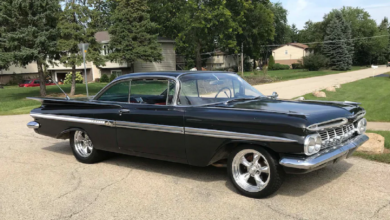The Miraculous Many-Wheeled Machines Of Milton O. Reeves
History seems to have painted Milton Othello Reeves (1864-1925) as a bit of a crackpot, perhaps, but that couldn’t be more wrong. A prolific inventor and successful manufacturer, he began his remarkable career at age 15. Working in a sawmill in Columbus, Indiana, he developed a variable-speed transmission that made the violent sawblade easier to handle. With his brothers Marshal and Girney Reeves, inventors in their own right, in 1888 they founded the Reeves Pulley Co. to manufacture and market the transmission. Meanwhile, another family enterprise led by Marshal, Reeves & Co., became a leading manufacturer of steam-powered farm tractors.
In 1896, Reeves built his first automobile, which he called a “motorcycle.” Powered by a two-cylinder, two-stroke Sintz engine coupled to his own variable transmission, it is said to be one of the first five automobiles constructed in the United States. Dissatisfied with the performance of the Sintz two-stroke, he then developed his own gasoline engines, which powered his own series of limited-production automobiles and were supplied to other automakers as well. Sears, Auburn, Moon, and Alexander Malcomson’s Aerocar Co. of Detroit were among the early manufacturers who used Reeves engines.
In the spring of 1911, Milt Reeves, who by then had become a bank president among his many endeavors, launched his most memorable product, the Reeves Octoauto. Based on an Overland 40-hp touring car, the eight-wheeler’s sole motivation was the horrrible roads of the day. Reeves theorized that the extra wheels would bridge the irregularities in the road surface, and he liked to compare the arrangement to the 12 wheels and six axles on a Pullman Palace luxury rail car.
One aspect of the Octoauto that has not been widely reported over all these years is the steering. While there was a single drive axle, the next to last, three of the axles steered: the front two and the last, with the back two wheels steering in the opposite direction from the front. The steering-linkage geometries of the three axles were each worked out to provide the smallest possible turning radius, in order to make the ponderously long machine more manageable in tight areas.
While the Octoauto reportedly worked well enough, it was heavy, cumbersome, and expensive, so Reeves next lowered his sights a bit and introduced the Sextoauto. In fact, the Sextoauto was the original Overland Octoauto chassis with the extra front axle removed. A second, improved Sextoauto was also produced, this one based on a more rigid and expensive Stutz chassis. Reeves ambitiously advertised the Sextoauto, but with a price of $5000 there were apparently no takers, and the Stutz was converted back to four wheels and became the family auto for a time. When Milt Reeves passed away on June 5, 1925, he held more than 100 patents and left a fortune of a million dollars—around $17 million in today’s money.







